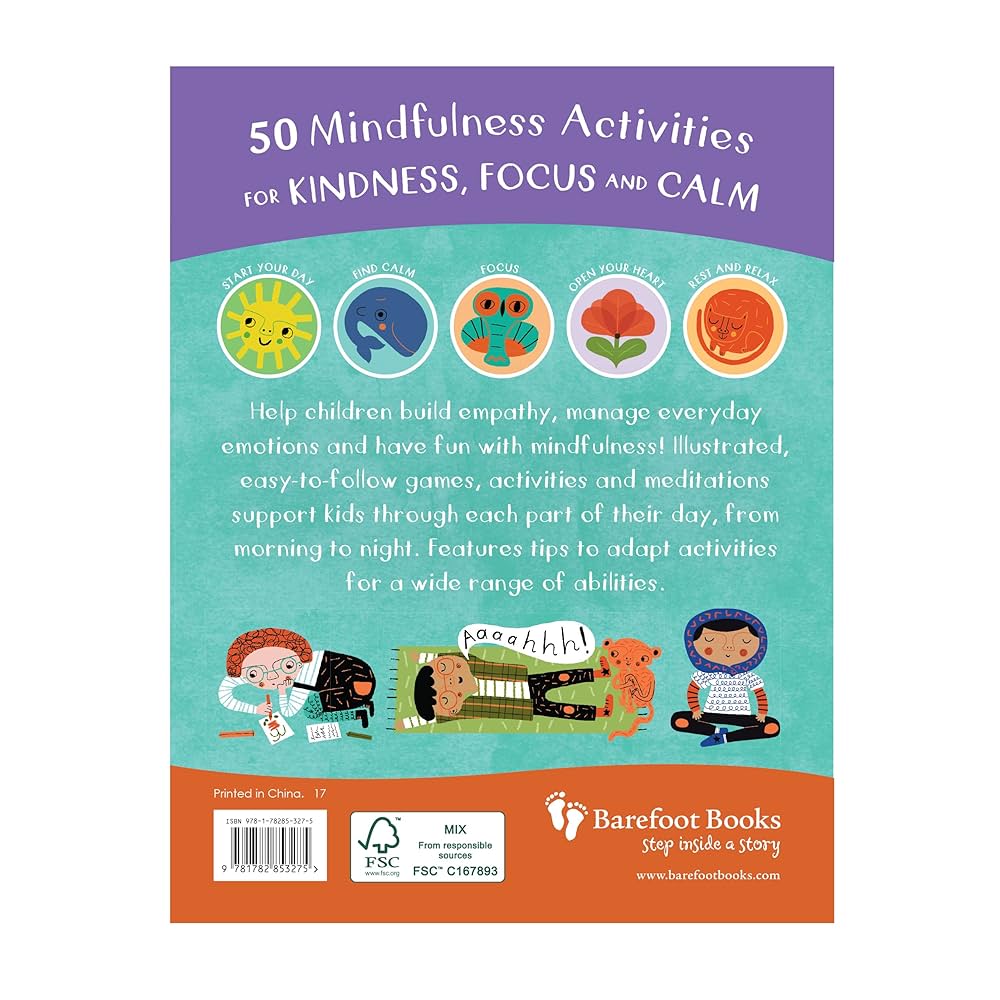In our busy lives, finding moments of peace can feel impossible, especially with kids around. However, incorporating mindful activities into your family routine can make a significant difference. By engaging children in simple practices like breathing exercises or creative arts, you not only foster their emotional well-being but also carve out those precious 15 minutes of tranquility for yourself. Let’s explore how these mindful activities can transform your home into a haven of serenity, providing both you and your children with the calmness you deserve.
Understanding Mindfulness for Kids
Mindfulness offers a transformative approach for children, encouraging them to connect with their emotions and the world around them. By incorporating mindful activities into their daily routines, kids can learn to focus their minds, reduce stress, and enhance emotional regulation.
Here’s what mindfulness entails for children:
- Being Present: Mindfulness teaches kids to live in the moment, appreciating what they see, hear, and feel without judgment.
- Awareness of Thoughts and Feelings: Children learn to acknowledge their emotions, allowing them to express themselves rather than suppressing their feelings.
- Relaxation Techniques: Through simple practices, such as breathing exercises, children can calm their minds and bodies, promoting overall well-being.
Benefits of Mindfulness for Kids
Mindful activities can significantly benefit children in various ways:
| Benefits | Explanation |
|---|---|
| Improved Focus | Helps them concentrate on tasks and lessons |
| Enhanced Emotional Regulation | Teaches how to manage feelings and respond calmly |
| Better Social Skills | Encourages empathy and active listening in friendships |
| Stress Reduction | Provides tools to cope with anxiety and stress |
By understanding mindfulness, parents and caregivers can create a nurturing environment that fosters peace and clarity. Embracing mindful activities not only promotes individual growth but also builds strong connections with others—essential for a balanced, happy childhood.

The Importance of Peaceful Moments
In our fast-paced world, even children experience overwhelming moments. This is where mindful activities come into play, offering important opportunities for peaceful moments that can significantly benefit their development.
Why Peaceful Moments Matter:
- Emotional Regulation: Mindful activities help kids understand and manage their emotions. Small pauses throughout the day allow them to process feelings rather than react impulsively.
- Focus and Concentration: Regular practice of tranquility boosts children’s attention spans. They become better equipped to engage in tasks without getting distracted.
- Stress Reduction: Just like adults, kids can feel stress. Incorporating mindful activities such as deep breathing or gentle stretching can reduce anxiety and foster a sense of calm.
- Enhanced Creativity: Peaceful moments encourage imaginative thought. When children take breaks to relax, their minds can wander freely, sparking creative ideas.
To nurture these peaceful moments in daily life, consider setting aside specific times for mindful activities. Whether it’s five minutes for deep breathing or fifteen minutes of quiet reading, these short breaks can transform how children approach their day.
Ultimately, fostering these moments of peace not only enhances children’s well-being but it deeply strengthens your relationship with them as you navigate life together.
Simple Breathing Exercises for Children
Introducing mindful activities like breathing exercises can be a delightful and effective way to promote calmness in children. These exercises not only help kids to relax but also teach them valuable skills for managing stress. Here are some simple breathing techniques you can try:
- Balloon Breathing:
- Instruct your child to take a deep breath in through their nose, imagining they are inflating a balloon in their belly.
- Then, have them slowly exhale through their mouth, visualizing the balloon deflating.
- Repeat this five times.
- Counting Breaths:
- Encourage your child to close their eyes and count their breaths.
- They can inhale for a count of four, hold for four, and exhale for four.
- This simple rhythm helps anchor their thoughts and extends their focus.
- Flower and Candle:
- Ask your child to imagine they have a flower in one hand and a candle in the other.
- Have them breathe in slowly, as if smelling the flower, and then exhale gently, as if blowing out the candle.
By incorporating these mindful activities into your child’s routine, you create opportunities for peaceful moments and emotional growth. Plus, these exercises only take a few minutes, making them perfect for a busy day. So why not give it a try?
Creative Arts and Crafts to Calm the Mind
Engaging in mindful activities like arts and crafts not only sparks creativity but also promotes a sense of peace. When children immerse themselves in these activities, they shift their focus from distractions around them to the present moment. Here are some creative and calming arts and crafts ideas:
- Collage Making: Gather various materials such as magazines, colored paper, and glue. Encourage kids to create collages that express their feelings or interests. This hands-on activity can be both relaxing and expressive.
- Painting with Watercolors: Set up a watercolor station, complete with brushes and paper. The gentle flow of watercolors creates mesmerizing patterns, encouraging children to let go of their worries as they paint.
- Nature-Inspired Crafts: Utilize natural elements like leaves, twigs, or flowers to create art. Creating art with nature helps kids connect with the environment, enhancing their sense of tranquility.
- DIY Stress Balls: Fill balloons with flour or rice. Decorating these stress balls allows children to express themselves creatively, while squeezing them can provide comfort during stressful moments.
Please click here to buy DIY Stress Balls from Amazon.
Incorporating these mindful activities into your child’s routine can lead to numerous benefits, such as improved focus, emotional regulation, and a deeper sense of calm. Remember, the goal is not to produce a masterpiece but to enjoy the process of creation. Engaging in creative arts and crafts together can create precious peaceful moments for both you and your child.

Nature Walks: Exploring the Outdoors
Engaging in nature walks serves as a magnificent mindful activity for kids that can foster peace and connection to the environment. By taking children outdoors, you not only promote physical activity but also help them develop perspectives that nurture mindfulness. Here’s how to make nature walks a calming adventure:
- Observation: Encourage kids to observe their surroundings. Ask them to notice different colors, sounds, and smells. This engages their senses and draws their attention to the present moment.
- Breathing: Integrate simple breathing exercises during the walk. For instance, suggest that children take deep breaths while counting the rustling leaves or chirping birds.
- Mindful Questions: Create opportunities for reflection by asking open-ended questions like, “What do you find most interesting about nature today?” This enhances critical thinking and deeper awareness.
- Nature’s Treasures: Collect leaves, rocks, or flowers as you walk. Discuss the textures and shapes, providing tactile experiences that reinforce mindfulness.
- Time to Share: After the walk, encourage kids to share their favorite moments or discoveries. This allows them to express their thoughts and connect with you.
Through these simple yet effective mindful activities, nature walks can transform into peaceful, enriching experiences that cultivate a lasting appreciation for the great outdoors.
Storytime: Adventures in Imagination
Storytime serves as a magical journey into the realm of imagination, and it’s one of the most delightful mindful activities for kids. Engaging young minds through storytelling fosters creativity while offering a peaceful escape from everyday life. Here’s how to make the most of this mindful activity:
Benefits of Storytime:
- Enhances Imagination: Children visualize the characters and settings, developing their creative thinking skills.
- Encourages Empathy: Stories often showcase various perspectives, helping kids understand and empathize with others.
- Builds Focus: Sitting quietly and listening hones concentration, a vital skill for their learning journey.
Tips for an Effective Storytime:
- Choose Engaging Books: Pick stories with vibrant illustrations and captivating narratives that resonate with your child’s interests.
- Create a Cozy Environment: Use soft cushions and dim lighting to create a peaceful reading nook that encourages relaxation.
- Incorporate Questions: Ask open-ended questions during the story to engage your child in discussion, reinforcing comprehension and imagination.
Storytime Ideas to Explore:
- Classic Fairy Tales: Timeless stories that capture wonder and spark creativity.
- Interactive Books: Choose books that involve sound or textures to engage the senses alongside imagination.
- Personalized Stories: Craft stories using your child’s name and favorite themes, making them the hero of their own adventure.
Incorporating storytime as a regular part of your routine provides children with comforting moments of mindfulness, promoting both tranquility and a love for reading.
Mindful Movement: Yoga for Kids
Incorporating mindful activities like yoga into children’s daily routines can significantly enhance their well-being. Yoga offers kids a unique way to connect their minds and bodies through purposeful movement and breath.
Here are some benefits of mindful movement:
- Encourages Focus: Children learn to concentrate during poses, improving their attention span.
- Promotes Calmness: Yoga helps release tension, fostering a sense of tranquility.
- Enhances Flexibility: Regular practice boosts both physical flexibility and emotional adaptability.
- Builds Confidence: Completing poses can boost self-esteem, making them proud of their abilities.
Simple Yoga Poses for Kids:
- Tree Pose: Encourages balance and concentration.
- Warrior Pose: Builds strength and confidence.
- Cat-Cow Stretch: Promotes relaxation and spinal flexibility.
- Child’s Pose: A great way to wind down and find peace.
Comparing Mindful Activities: Yoga vs. Other Techniques
| Technique | Focus on Breath | Physical Activity | Mental Calm |
|---|---|---|---|
| Yoga | Yes | Moderate to High | High |
| Deep Breathing | Yes | Low | Moderate |
| Creative Arts | No | Variable | High |
By integrating mindful activities like yoga into your child’s day, you provide them with tools to manage their emotions and stress, paving the way for a more peaceful and joyful life. Encourage them to explore this enriching practice, and enjoy those precious 15 minutes of peace together!

Sensory Play: Engaging the Senses
Sensory play is an incredible way to introduce mindfulness to kids while engaging their senses. By using various materials and experiences, children can explore textures, sounds, and sights, which helps ground them in the present moment. Here are some delightful mindful activities focused on sensory exploration:
- Texture Boxes: Fill different boxes with items like rice, sand, or fabric scraps. Encourage kids to feel and describe each texture, promoting focus and awareness.
- Scented Playdough: Create homemade playdough using scents like lavender or citrus. As children mold and shape, they inhale the soothing aromas, bringing a calm and relaxing experience.
- Sound Jars: Fill jars with various materials (e.g., dried beans, pebbles) and let kids shake them to hear different sounds. Discuss how sound can evoke feelings, enhancing their auditory mindfulness.
- Water Play: Set up a tub or basin with water and various objects like sponges and cups. Children can explore floating and sinking, enhancing their sensory experiences while they focus on the water’s temperature and movements.
Incorporating these mindful activities into daily routines not only calms the mind but also nurtures curiosity and creativity. By engaging the senses, kids develop a deeper appreciation for their environment, fostering peace and awareness in their everyday lives.
Journaling: Expressing Thoughts and Feelings
Journaling serves as a powerful tool for children, allowing them to express their thoughts and feelings in a safe environment. By engaging in mindful activities like journaling, kids can better understand their emotions, which is crucial for their emotional development.
Benefits of Journaling for Kids:
- Emotion Regulation: Writing about feelings helps kids process emotions and reduces anxiety.
- Enhanced Creativity: Encourages creative thinking, allowing children to explore their imaginations.
- Improved Writing Skills: Regular journaling sharpens writing abilities and vocabulary.
- Mindfulness Practice: Promotes reflection and mindfulness by focusing on the present moment.
How to Encourage Journaling:
- Set a Routine: Create a specific time for journaling each day, helping establish it as a calming ritual.
- Provide Materials: Offer colorful notebooks and fun writing tools to make the activity appealing.
- Prompt Ideas: Suggest prompts like “What made you smile today?” or “Draw your happy place” to spark inspiration.
Journaling vs. Other Mindful Activities:
| Activity | Emotional Expression | Creativity Boost | Mindfulness Focus |
|---|---|---|---|
| Journaling | High | High | Medium |
| Drawing | Medium | High | Low |
| Breathing | Low | Low | High |
By incorporating journaling into daily mindful activities, children learn to express themselves, fostering a sense of peace and self-awareness. Give your little ones the gift of a journal; it might just become their favorite way to unwind!
Mindful Listening: The Power of Sound
Mindful listening serves as a beautiful way to help kids remain present and engaged. It nurtures a sense of awareness, develops concentration, and grants them a peaceful moment of respite from the day’s hustle. Here’s how to incorporate mindful activities focused on listening into your routine:
- Create a Sound Jar: Fill a jar with rice and different items that create sounds when shaken, such as bells, marbles, or dried beans. Ask your child to close their eyes and listen carefully. Encourage them to describe the sounds they hear, promoting both focus and descriptive skills.
- Nature Sound Walk: Take a short walk outside and encourage your child to listen to the sounds around them—birds chirping, leaves rustling, or distant voices. Mindful activities like this enhance awareness of the serene aspects of nature.
- Musical Moments: Play calming music or nature sounds and ask your child to focus solely on the music. Ask them to identify different instruments or sound patterns. This activity not only stimulates their auditory senses but also provides a delightful sense of peace.
- Sound Scavenger Hunt: Create a list of sounds to find, such as a barking dog, a flowing stream, or wind through the trees. This not only fosters mindfulness but adds an element of curiosity to the activity.
Incorporating mindful listening into your child’s day can yield peaceful moments that enrich their emotional well-being while instilling appreciation for the world around them.

Creating a Peaceful Space at Home
Establishing a peaceful environment at home can significantly enhance the effectiveness of mindful activities for kids. A serene space encourages relaxation and focus, making it easier for children to engage in mindfulness practices. Here are some tips to create that ideal haven:
- Designate a Quiet Area: Choose a corner of a room or a specific area where distractions are minimal. Ensure this space is away from noise and clutter.
- Use Soft Colors: Opt for soothing paint shades or decor. Soft blues, greens, or pastels can create a calming atmosphere that promotes relaxation.
- Incorporate Natural Elements: Bring in plants, stones, or water features. Nature tends to foster peace, allowing children to connect with their surroundings while engaging in mindful activities.
- Add Comfort Items: Include cushions, soft blankets, or beanbags. Cozy seating can encourage kids to relax and focus on their thoughts during mindfulness exercises.
- Limit Technology: Design a screen-free zone. By turning off electronic devices, children can immerse themselves in mindful activities without distractions.
- Rotate Mindful Tools: Consider having materials like coloring books, journals, or meditation pillows available, and rotate them periodically to maintain interest.
Creating a peaceful space enables children to explore mindful activities and develop habits that promote emotional well-being. Ultimately, a tranquil environment helps instill a sense of calm, making it easier for kids to practice mindfulness daily.
Frequently Asked Questions
What are some examples of mindful activities for kids?
Mindful activities for kids can include practices such as guided breathing exercises, nature walks where they observe their surroundings, coloring or drawing, simple yoga poses, and storytelling sessions that encourage imagination. Each of these activities promotes focus and being present in the moment, allowing children to develop mindfulness naturally while also fostering creativity and connection with the environment.
How can I encourage my child to participate in these activities?
To encourage your child to participate in mindful activities, start by making them engaging and fun. You can join them in these activities or turn them into a playful challenge. Explain the benefits, emphasizing how these activities help in reducing stress or improving concentration. Creating a soothing environment, free from distractions, and establishing a routine around these activities can also significantly motivate your child to partake willingly.
What age group are these mindful activities suitable for?
Mindful activities can be adapted for all age groups, but they are especially beneficial for children aged 4 to 12 years. Younger children may enjoy simpler, playful activities like sensory play and short storytelling, while older children can engage in more structured mindfulness practices, such as yoga or meditation sessions that focus on breath and perspective. The key is to tailor the activities to their developmental level for maximum engagement.
How can these activities benefit my child’s mental health?
Mindful activities can significantly enhance your child’s mental health by teaching them essential skills for managing emotions and stress. These practices promote self-awareness and emotional regulation, helping children recognize their feelings and respond to them constructively. Over time, regular mindfulness can improve focus, reduce anxiety, and build resilience, which equips them better to navigate the challenges they face in everyday life.
Can I do these activities with my child?
Absolutely! In fact, participating in these mindful activities together can strengthen your bond with your child. It not only provides them with a supportive presence but also allows you to model mindful behaviors. Engaging in these activities as a family can create a shared experience that encourages open communication and helps your child feel more comfortable practicing mindfulness on their own.
